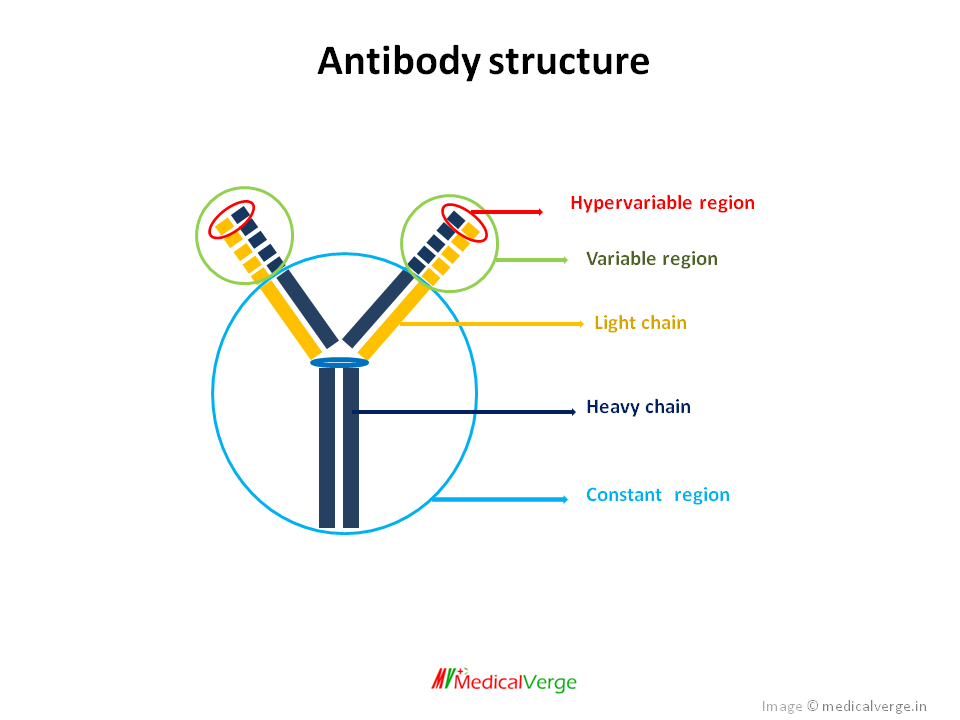Immunotoxins are a new class of large molecules and targeted anticancer drugs. It is a conjugated protein containing an antibody, growth factor, or cytokine that binds directly to target cells and toxins (e.g. Diphtheria toxin) joined together with a pH-sensitive cross linker that serves as a disulfide bond in between. Like “magic bullets,” it destroys cancer cells or virus-infected cells while having little or no effect on healthy cells.
Components of Immunotoxins
Antibody fragments
The hybridoma technique is used to create monoclonal antibodies. Antibodies have a large molecular mass, which limits their penetration into solid tumors with limited blood supply. A protease enzyme cleaves off the Fab portion of a monoclonal antibody to minimize its size. Currently single chain variable (scFv) fragments (VL & VH) obtained by cloning into bacteria, which is a most favored method. VL & VH domains are than stably tethered together with flexible polypeptide linker. Cytokine and interleukins are produced by recombinant DNA technology, though plasmid transfer in E-coli bacteria.

Toxins
Toxins are derived from bacteria, fungi and plants. Most commonly toxins are produced in Escherichia coli transformed with a plasmid encoding the recombinant toxin. They exhibit their function by inhibiting protein synthesis. Bacterial toxins kill cells by inhibiting the ribosome accessory protein called elongation factor-2 (EF-2) while plant originated toxins cleaves single adenosine from r-RNA.
Examples of toxins used in making Immunotoxins are:-
- Bacterial toxins
Diphtheria toxin (DT)
Pseudomonas exotoxin (PE)
Anthrax toxin (AT)
- Plant toxins – they are mostly ribosome inactivating proteins.
Ricin chain A (RTA)
Gelonin
Abrin
Pokeweed anti-viral protein
Dodecandron
Linker
A cross linker connects the targeting moiety and the toxin. Internal disulfide bonds exist in the linker substance, which are stable extracellularly (in an oxidizing environment) but labile intracellularly (in reducing environment).

Mechanism of Immunotoxins
Immunotoxins floats in the blood stream until they bind to their intended target cells. The antibody part (Fab) binds to the cell surface target receptor. Immunotoxin & receptor complex internalized by endocytosis, where it localized to an acidified endosome (eg. DT) or the endoplasmic reticulum or trans-golgi apparatus. In a reducing environment, the disulfide bond of the linker breaks. As a result, the linker that holds the toxin to the antibody is cleaved, and the free toxin exerts its cytotoxic effect by inhibiting protein synthesis of the cell.

Uses of Immunotoxins
| S.N. | Immunotoxin | Toxin | Antibody/GF | Uses | Status |
| 1 | LMB-2 | Pseudomonas exotoxin (PE) | Murine monoclonal Ab against CD-22 | HCL (Hairy cell leukemia) | Clinical development phase |
| 2 | BL-22 (Moxetumomab pasudotox) | Pseudomonas exotoxin (PE) | monoclonal Ab against CD-22 | Lymphomas | US-FDA approved |
| 3 | Denileukin diffitox | Diphtheria toxin (DT) | Recombinant IL-2, which acts on CD-122 and CD-132 | Cutaneous T-cell lymphoma | US-FDA approved |
| 4 | 8H9-PE38 | Pseudomonas exotoxin (PE) | monoclonal Ab 8H9 | Neuroblastoma, RCC, childhood sarcoma, Brain tumor, breast carcinoma | Clinical development phase |
| 5 | RFT5-SMPT-dgA (Imtox-25) | Deglycosylated ricin-A chain (dgA) | RFT-5 murine monoclonal Ab | Hodgkin’s disease | Clinical development phase |
Limitations of Immunotoxins
Vascular leak syndrome
The carbohydrate residue of ricins, truncated Pseudomonas exotoxin, or IL-2 ligand can bind to endothelial cells in capillaries, causing cell lysis through a mechanism different from that of usual toxins.
Renal toxicity
Recombinant Immunotoxins are excreted primarily through the kidneys, which can cause renal toxicity.
Hepatotoxicity
Hepatotoxicity can result from the binding of basic monoclonal antibody residues to negatively charged hepatic cells.
Immunogenicity
Immunotoxins, like all monoclonal antibodies, can trigger an immune response. Treatment failure may result from anti-Immunotoxin antibodies.
Production of Immunotoxin
It is a time-consuming and resource-intensive process. Advanced technology and well-trained personnel are needed.